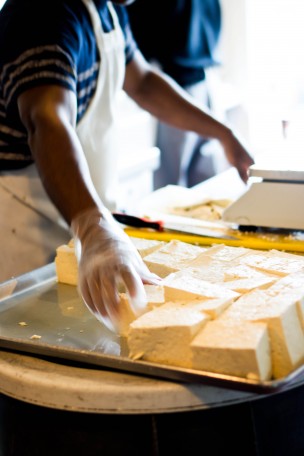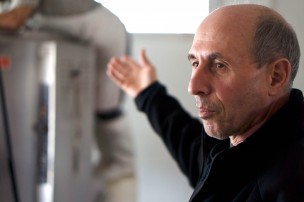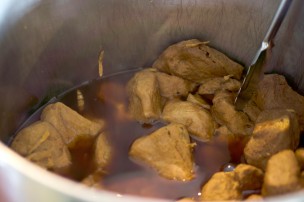Stephen Lapenta, owner and president of The Bridge, has an affection for tofu that is profound, even emotional.
It’s a good thing he does, because tofu is at the core of daily operations at The Bridge, a factory in Middletown that produces bean curd, seitan, tofu salad, and a Japanese condiment called amasae. Standing in the main room of his tofu factory, as rattling machines drown out his soft voice and carts of bean curd roll past, Lapenta is totally in his element as he talks about just what exactly makes tofu so special.
“It’s a flavor sponge,” Lapenta said, holding up a block of packaged tofu. “Tofu doesn’t discriminate. It’s sitting there saying, ‘Take me!’”
Although he acknowledged that tofu’s blandness and puzzling texture can prove gastronomically challenging for some people, Lapenta knows that tofu is well worth the effort of figuring it out.
The Bridge opened its doors for the first time in 1978, and Lapenta took over in 1981. He and a group of friends moved to Middletown in the mid-1970s in pursuit of alternative food options, and they lived in a quasi-commune of food explorers.
“Middletown in the 1970s was a hub if you wanted to study macrobiotics,” Lapenta said. “I was living in a town outside of Hartford, and through other friends I met [a community of new friends], listened to what they had to say, ate what they were cooking. We developed friendships, but also the food was delicious. I was really attracted to a healthy way of eating that was also delicious.”
His friends have since moved away, leaving Lapenta to determine the fate of The Bridge by himself. The job has been demanding at times, especially the time a flood destroyed the half of the factory that operated as a café, offering prepared versions of the food produced by The Bridge. Mostly, though, things have gone smoothly.
Not much has changed in 33 years, Lapenta said, but that’s o.k. with him.
“We’ll just stay where we are for the time being,” he said, looking around with a small nod of approval. “We’ve stayed here for 30 years. I don’t see a big expansion; I don’t see us going away.”
From the outside, The Bridge itself resembles a block of tofu: the building is white, cubic, and compact, without a sign or any other marker. It is located far down Washington Street, past a consignment shop and a couple of gas stations. The Bridge hardly looked like the factory we were expecting.
On the inside, though, The Bridge was alive. Huge vats bubbled and spilled over onto the floor, leaving a layer of tofu juice underfoot. Men in white aprons bustled back and forth, from machine to stovetop to pressing stations; one stood and cut thin slices from newly finished blocks of bean curd. As soon as he finished one tray, another arrived by his side. It was like Santa’s workshop, if every present were a block of fresh tofu.
Lapenta was in his office when we arrived. We waited for him to finish his phone conversation, and, once he saw that he had visitors, he immediately launched into a tour, grabbing a handful of wet soybeans from a nearby vat and pressing them together in his fingers to show us how soft they were.
“These soybeans soak for 24 hours,” Lapenta said. “Then they’re ground up, added to boiling water, and drained so that the solids separate from the milk.”
After the addition of magnesium oxide, the milk separates into curds and water, Lapenta explained. It is the curds that cool and become tofu, which is pressed in cloth to soak up unnecessary juices. The tofu is then sliced, packaged, and shipped off to its various destinations.
Although the Bridge produces 800 pounds of tofu per week, it is always working a bit behind schedule because demand exceeds supply. Between 10 and 15 buckets go to the University, and much of the rest is sold in New York and Boston. The factory also makes 200 weekly pounds, give or take, of seitan, 70 to 100 pounds of which arrive at Wesleyan kitchens.
Lapenta and his team also make tofu salad and amasae, or “almost sake” in Japanese. Amasae is fermented rice while it is still sweet, before it becomes alcoholic—which might explain why there is no demand for it on campus.
Each of his four products is made with care, and Lapenta is very conscientious about his selection of ingredients. The freewheeling 1970s are behind him, but Lapenta still clings to the organic lifestyle he sought in Middletown.
“We get our soybeans from upstate New York, and they’re certified organic,” he said.
An animal rights advocate, Lapenta rarely eats meat and is eager to educate the public about all that non-animal proteins have to offer. His favorite tofu recipe, which can be found on the company’s website, is the surprisingly simple pan-fried tofu.
“The future of animal protein is bleak, not because people don’t like it—they do—but because it’s unsustainable, and it’s incredibly expensive,” Lapenta said. “If you ever looked at what happens to animals, for them to be processed for you to eat, you wouldn’t want to have it.”
Lapenta’s rationale for naming the company The Bridge also stems from his belief that the future of food has a lot to learn from the past.
“It’s not named after the Arrigoni Bridge,” Lapenta said with a laugh, referring to the bridge over Washington Street that one passes under while walking from campus to the factory. “It’s a metaphorical bridge. Our tag line is, ‘‘Traditional foods for modern times.’ That’s the bridge, between traditional and modern.”
Modern food, according to Lapenta, has had extremely negative effects on our society, as well as on other societies that have adopted our eating habits.
“As far as food goes, modern food is funny,” he said. “It’s extremely highly processed and refined food. It’s not good for you. It’s changing our society. That’s O.K. for some people, but it’s not okay for me.”
After all, Lapenta reasons, healthy eating is the linchpin and the starting place for overall wellbeing.
“The importance of what you eat cannot be underestimated,” he said. “There’s not too many things you control besides what goes in your mouth.”


